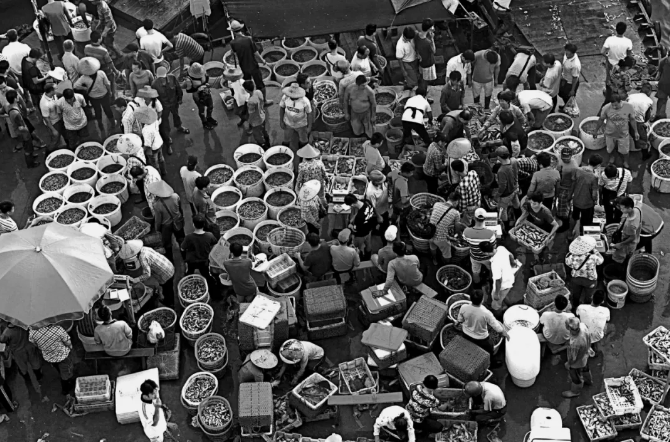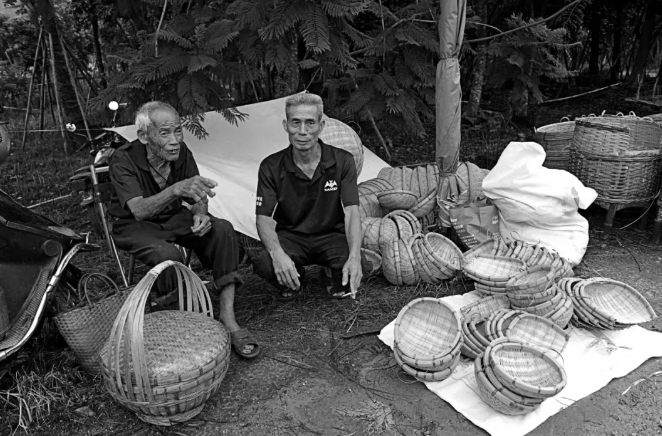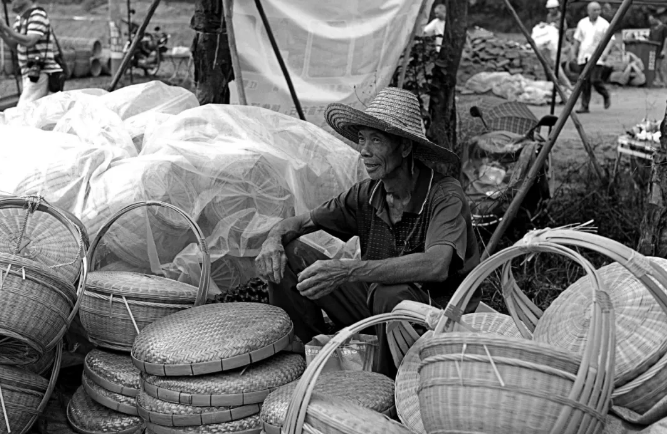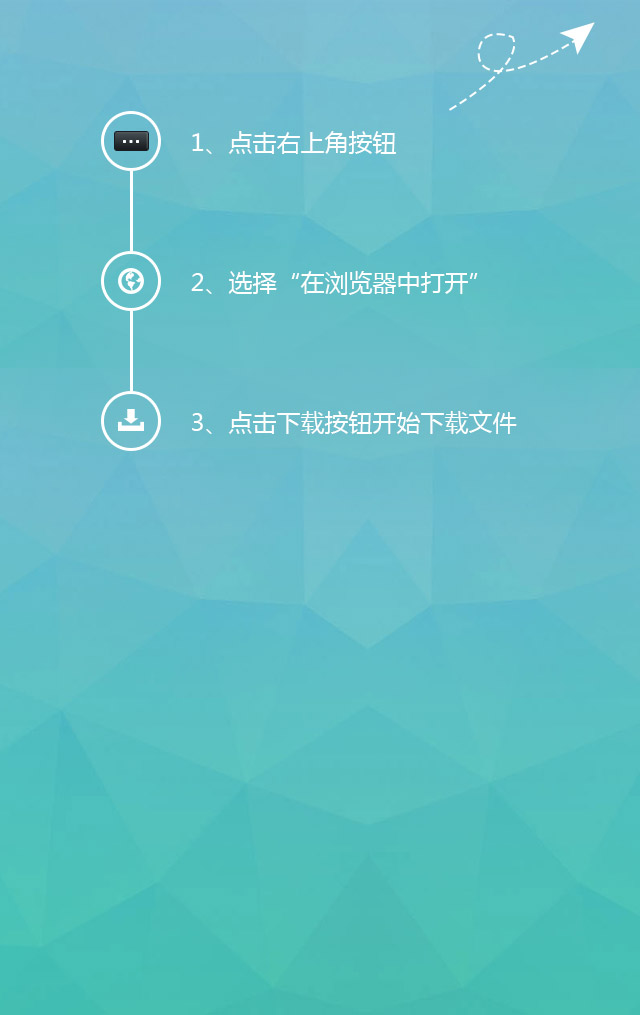名家推介 | 邓伟群《粤西墟市》

镜头向下,展现粤西百姓生活变化
——品读邓伟群《粤西墟市》系列作品
吴吕明
粤西,是广东省西部地区的简称。粤西背山面海,海岸线长,港湾众多;既是广府民系的另一个传统聚居地,又集广东粤、闽、客三大族群于一身,历史上还出过不少名人,如冼太夫人、唐代重臣高力士、岭南著名才子陈鉴等,文化底蕴厚重,自然山水与人文古迹交相辉映,年例、飘色等传统风俗保持不变,风情浓郁,地方特色鲜明。
广东作为中国摄影的发祥地和前沿地,作为一个摄影大省,长期以来摄影力量分布不均,粤西就是比较薄弱的地方。但实际上,粤西地区一直就是一个藏龙卧虎之地,这里出过不少广东有名的文化人和艺术家。不论是“地灵人杰”,还是“人杰地灵”,地域环境与文化传承,都会促进艺术创作的灵感与产出。
出生于粤西茂名照相世家的邓伟群,就是当地颇有名望的摄影大家。因为出生于照相世家,他父亲在粤西茂名电白县的坡心镇、林头镇都有照相馆,所以他在读高中的时候就已经拿海鸥相机帮同学们拍片了,后来他新加坡的亲戚回来探亲,带了一部德国产的禄来福来相机送给他父亲,他父亲转送给他,他就拿着这部相机更勤快地拍片创作了。作为下乡知青,1975年回城后,邓伟群被安排在教育局教学仪器厂工作,负责整个教育系统宣传、拍摄。从那时起,他拍摄了很多新闻图片,开始陆陆续续在《湛江日报》刊登(那时候湛江地区行政公署管辖茂名、电白、阳江、阳春),并被聘为湛江日报通讯员。1980年夏天,广东省摄影家协会在肇庆举办了一个全国性的大型摄影讲习班,邀请了新华社蒋齐生等老师来讲课,学习进一步拓宽了他的摄影观念,也更加坚定了他“把镜头对准生活”的纪实报道摄影方向,将镜头向下,关注粤西这片土地,拍摄这片土地,把焦点对准这片土地和人们的生活状态。从1980年代开始,邓伟群拍摄的很多粤西新闻照片被《南方日报》、《广东农民报》、《广东画报》选用刊登,也因为发稿量大而被聘为南方日报通讯员。正因为邓伟群具有良好的影像视觉艺术素养,又熟悉地方社情,因此在后来成立电白县电视台时被调入电视台担任记者,从摄影摄像第一线一直做到茂名市电白区原广播电视台副台长、总编辑,期间拍摄的电视专题片《荔枝红了》、《前进中的电白》还曾在中央电视台展播。除了精研业务,邓伟群还积极带动身边喜好摄影的人士一起进步,以自己的热量,尽心推动茂名摄影更上层楼。特别是2016年当选茂名市摄影家协会副主席,更是尽心尽力配合主席做好协会工作,开展“请进来”“走出去”等活动,为茂名摄影打开新局面奉献自己的力量。
邓伟群的《粤西墟市》系列,坚守摄影纪实的传统理念,选取粤西人独具特色的墟集市贸,拍出了饶有风味的粤西新视觉。尽管《粤西墟市》选取的题材饶有趣味,例如千年渔港“博贺渔市”、湛江雷州的“阴阳圩”、一年一度的“阳春高流墟”、茂名“化州牛墟”,但邓伟群的拍摄并没有刻意去追求奇观,恰恰就是平凡朴实,没有什么奇特情景,还原生活的自然状态,记录下时代的观看,更显得情真意切、意蕴悠长。邓伟群的作品,正是坚持深入生活、扎根人民,体现了“坚持以人民为中心,用心用情用功为人民画像”,创作生产出无愧于我们这个伟大民族、伟大时代的优秀作品。

邓伟群,广东电白人,中国摄影家协会会员,广东省摄影家协会会员,广东省摄影家协会理论委员会委员,广东省茂名市摄影家协会副主席;广东省茂名市电白区原广播电视台副台长、总编辑。
博贺渔市
Bohe fishing market
博贺,是我国十大渔港之一,是广东省著名的渔港,年海洋捕捞量16.5万吨,产值13.88亿元。博贺渔市是广东省最有特色的鱼市,每天凌晨3点起,一艘艘满载着白虾、虾姑、尤鱼、金丝鱼、龙利、马胶、黄尾、白仓、黑仓等的鱼船陆续回港,鱼市交易火旺,热闹非凡。10多万斤海鲜当天卖完,因为海鲜产品丰富、价格适宜,粤西各地的渔贩都赶来这里贩运海鲜到广州及珠三角等地,这里形成有名的渔港早市。
Bohe, one of the top ten fishing ports in China, is a famous fishing port in Guangdong Province, with an annual marine fishing amount of 165,000 tons and an output value of 1.388 billion yuan. Bohe fishing market is the most distinctive one in Guangdong Province. From three o'clock every morning, there are boats full of white shrimps, mantis shrimps, squids, white cloud mountain minnows, sole fish, mackerels, yellowtails, white pomfrets, black pomfrets, etc. Returning to the port, and the fishing market is bustling with trade. Seafood products here are rich in variety and affordable, so the seafood weighing more than 50,000 kilograms can be sold out on the same day. Fish merchants from all over Yuexi come here to transport seafood to Guangzhou, the Pearl River Delta and other places, which has formed a famous fishing port morning market.






粤西墟市,最体现粤西人文生活的独特风貌和地方特色。千年渔港“博贺渔市”、湛江雷州“阴阳圩”、一年一度的“阳春高流墟”、茂名“化州牛墟”……弯弯的小路,窄窄的巷道,熙熙攘攘的趁墟人,无不诉说着古墟集市的生活故事。今天的现实就是明天的历史。现实中的墟市生活,风情百态,但随着时代的不断演变,有些已经在转变,甚至息微,也许若干年后这些墟市就成为了另外形式。粤西墟市,不仅是历史记录,是粤西记忆的重要部分,也是我挥之不去的乡愁。乡村的墟市,生活关系简单、朴实,满满的浓郁乡村人情味,是如此独特、自在、悠然又多姿多彩。我喜欢粤西墟市那种自由自在的野性纯洁,以及那种热闹的乡情。赶墟人的吆喝声、六畜禽鸟的呼叫声,还有不时混杂的雷剧地方小曲,汇集了一部墟市奏鸣曲,回响在粤西广阔田野。别有情趣,但只有用心去体验发现,才会感受得到。
The fairs in Yuexi feature the local humanity and community. The millennium fishing port “Bohe fishing marketplace”, “Yin-Yang fair” in Leizhou, Zhanjiang, the annual “Gaoliu fair” in Yangchun, “Huazhou cattle fair” in Maoming…..Winding alleys, narrow lanes, bustling people, all these things can reflect the real local life. Today will be tomorrow's history. Today's fairs are full of all kinds of local conditions and customs, but with the continuous evolution, some of them have been changing or even disappeared. Maybe after several years, these fairs will changed into something else. The fair in Yuexi is not only a historical record, and an important part of the memory of Yuexi, but also the places where I get homesick. In the village fair, the villagers are very simple,plain and leisurely, and the atmosphere is full of strong rural human interest, so uniqueand comfortable. I like the free and purity of the fair in Yuexi, as well as the lively country style. The shouts of the market vendors, the cries of animals and birds, and the occasional jumble of local tunes of Lei Opera, form a fair sonata that resounds in the vast fields of Yuexi. It has a unique interest, but you can feel it only with your heart.
化州牛墟
Huazhou cattle fair
化州牛墟,是粤西地区最大的耕牛集散地。主要交易品种有黄牛水牛耕牛,菜牛。每个墟期交易额达100多万。粤西地区有部分农民靠养牛致富脱贫,他们盖起了小洋楼,日子过的红红火火。
Huazhou cattle fair is the largest cattle gathering and distributing center in Yuexi. The main varieties of trade at the fair are cattle, buffalo, and beef cattle. The trading volume on each market day is more than 1 million yuan. Some farmers in Yuexi got rich out of poverty by raising cattle. They built small western-style buildings and have been living a prosperous life.




雷州阴阳墟
Leizhou Yin-Yang fair
粤西雷州市的杨家镇井尾坡村,有一个匪夷所思的集市“阴阳圩”。井尾坡村边上有一片像所有农村坟地一样寂静荒凉的村民坟场。每到农历3月22日,人们就忘却了顾忌,从半夜开始就有摊贩将各种各样的商品摆在坟头贩卖,人来人往,和一般乡市无差,甚至更热闹。赶集的人来自四面八方,甚至远道而来,呈现万人逛“鬼圩”的场面。相传兴起于清乾隆年间的“鬼圩”,至今从未间断。传说逛“鬼圩”买一个物品可以得吉利。远久的传说诱惑人的好奇心。事实上,农历三月适逢农闲时节,百姓把自家编织、制作的竹器等生活及生产用具进行出售以换取生活所需,并且迷信认为“神鬼触摸过的”(东西)不会蛀虫(耐用)。鉴于这是在一片坟茔密布的“鬼地”小山坡,形成的一年一度、朝聚暮散的一日市集,所以当地百姓称之为“阴阳圩”。时至今日,尽管时代变迁,“鬼圩”依然继续,只是销售的除了竹木制品,其他的家电、服装、食品、药品等等都应有尽有,成为一个现代集市了。
In Jingweipo Village, Yangjia Town, Leizhou City, Yuexi, there is an inconceivable fair called “Yin-Yang fair”. On the edge of Jingweipo Village, there is a villagers’ cemetery as quiet and desolate as all the rural cemeteries. On the 22nd day of the 3rd lunar month every year, people ignore taboos and some vendors start selling all kinds of goods beside the cemetery from midnight. The fair is as bustling with people as any other fairs and is even livelier. People from all directions come to the fair, and some even come from far away, thus appearing the scene of ten thousand people visiting the “Ghost Fair”. According to the legend, “Ghost Fair” has been continuing from the term of Emperor Qianlong in the Qing Dynasty. It is said that buying an item at the “Ghost Fair” can get good luck. The long-standing legend tempts people's curiosity. In fact, the third month of the lunar calendar falls in the slack season, and people sell bamboo wares and other living and production tools woven or made by themselves in return for necessities, and superstitiously believe that (things) “touched by ghosts” will not be worm-eaten (durable). Given that the annual one-day fair was formed on a hillside full of tombs, the local people called it “Yin-Yang fair”. Today, “Ghost Fair” still continues, but in addition to bamboo and wood products sold in the fair, there are also various items such as home appliances, clothing, food, medicine and so on. It has become a modern fair.




阳春高流墟
Gaoliu fair in Yangchun
这是一个传承千年的岭南墟集。从公元558年,每年的农历五月初四“约定成集”,成为高流河墟日,开创了粤西民间商业贸易的先河,成为农副产品等的交流盛会。一年趁一次的高流墟,位于广东省阳春市合水镇高流河。高流墟所摆卖的商品以竹器为主,来自阳春及周边县、市的商贾便将自产的竹、木制品以及农具、工艺品、农副产品等。每一年的墟日,墟场人气鼎盛,省道113线高河村段两旁的车辆都会排起长龙,来得晚了要找个车位停车都相当困难。岁月更迭,物转星移,高流河墟也在不断变化,现在的高流墟市更因闻名遐迩而成为一个民俗传统的旅游节点,盛况空前。
This is a fair in Lingnan that has been inherited for thousands of years. From 558 AD, the 4th day of the 5th lunar month was agreed as “the day for fair” each year, which became Gaoliuhe fair day. As an exchange event of agricultural and sideline products, etc., it created a precedent for folk commercial trade in Yuexi. The annual Gaoliu fair is located in Gaoliu River, Heshui Town, Yangchun City, Guangdong Province. The commodities for sale in Gaoliu fair are mainly bamboo wares. There are bamboo and wood products, farm implements, handicrafts, and agricultural and sideline products produced by merchants from Yangchun and surrounding counties and cities. Every year, with long queues of cars lining Gaohe Village section of highway 113, the fair is very popular, lively and crowded. As time goes by, everything is changing, and so is Gaoliuhe fair. Today, the Gaoliu fair is more famous than ever as a traditional folk tourist resort.





推荐
-

-

QQ空间
-

新浪微博
-

人人网
-

豆瓣

